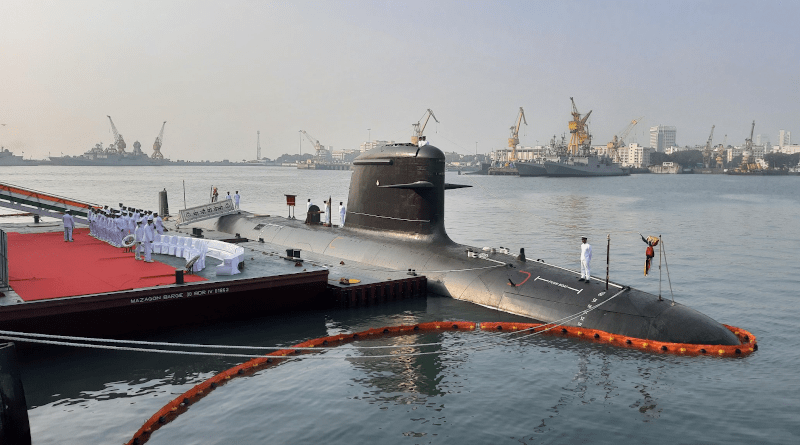- Background
The Indian Navy’s Advanced Technology Vessel (ATV) project to design and construct a nuclear submarine took shape in the 1990s.The initial intent of the project was to design nuclear-powered fast attack submarines, though following nuclear tests conducted by Pakistan in 1998 at Chaghi Hills made India change this project into Nuclear powered Ballistic Missile Submarine (SSBN) from Nuclear-powered fast attack submarines (SSKN).
- Development
On May 19,1998, Project ATV was confirmed by the defense minister of India George Fernandes. They were developed under the US$12 billion Advanced Technology Vessel (ATV) project to design and build nuclear-powered submarines. The plan was to build 4 SSBNs (S2, S3, S4, S4*).
The S4 and S4* were to be more advanced in terms of launch tubes (4 more) and armament as compared to the previous S2(Arihant) and S3(Arighat).
- Design
Arihant’s design is based on the Russian Akula Class submarine. Russian engineers played a primary role in designing the submarine. The submarine’s exterior is uneven, and the hull is placed on a mat covered with tiles. Compared to conventional submarines, the conning tower of Arihant is situated near the bow instead of the centre.
The central part of the submarine’s body consists of the outer hull and an inner pressurized hull. The starboard side consists of two rectangular vents that draw in water when the submarine submerges into sea.
- Control and communication systems
Arihant is fitted with a combination of two sonar systems. Ushus and Panchendriya. Ushus is the improved version of Russian MGK-400 sonar used on Kilo Class submarines. Panchendriya is a unified submarine sonar and tactical control system, which includes all types of sonar (passive, surveillance, ranging, intercept and active). It also features an underwater communications system.
- Power Reactor
The most important component of a nuclear-powered submarine is undoubtedly the nuclear reactor. Firstly, we must understand one thing:
“You don’t design a reactor to fit into a submarine. You design a submarine to fit around the reactor.”
Two types of reactor technologies were available to India Light Water Reactors (LWR) & Pressurized Heavy Water Reactors (PHWR).
LWRs use enriched Uranium or MOX as fuel & are cooled by light water whereas PHWR use natural Uranium & are cooled by heavy water. The difference between Light & Heavy waters is the isotope of hydrogen in the water, the former has protium & the later has deuterium.
Adopting any of the 2 reactor types brought its own technological challenges as India then could neither enrich Uranium nor produce heavy water. This was a very critical choice for India but as the India was using Russian nuclear submarines, so it chooses PHWRs as the way ahead.
The boats are powered by a single seven blade propeller powered by an 83 MW pressurized water reactor (PHWR) B1 which is heavily based on the Soviet VM-4 reactor, designed by NIKIET. This is the same type that powered the Charlie-class SSGN that India leased between 1988-91. It included a 42-metre (138 ft) section of the submarine’s pressure hull containing the shielding tank with water and the reactor, a control room, as well as an auxiliary control room for monitoring safety parameters.
On 11th November, 2003 the prototype of the reactor was made but it was very critical and had many issues including less power delivery. Again, on 12th September 2006 2nd prototype of reactor was tested where it produced about 83mwT (megawatt thermal) using 40% enriched HEU fuel.
The B1 PWR was still inferior to VM-4 reactor, but the project was already delayed so this reactor was finalized for Arihant class submarines but the weapons capacity on submarines was compromised.
- Armament
The submarine can fire 533mm torpedoes from 6 torpedo tubes probably Varunastra.
Due to the underpowered nuclear reactor the submarines have four launch tubes in their hump and can carry K-15 Sagarika missiles with one warhead each (with a range of 750 km or 470 mi).
India plans to replace the K-15 missiles by 3500km range K5 missiles recently tested on 24 Jan,2020 from a fixed underwater pontoon on the east coast.
But it does not seem possible because the submarines are already underpowered and can’t carry more payload due to its 83MW reactor. Any extra additions like cruise missile VLS would further burden the power requirements, compounding its speed disadvantage.
- Tests and delivery
The first submarine Arihant was launched for sea trials on 26 July 2009 and was due to be commissioned in 2011. The trials were being conducted at a concealed test area called ‘Site Bravo’ but the submarine had problems in the propulsion and also with the speed being underpowered.
On 13 December 2014, the submarine again set off for its extensive sea trials.
In 2016 the first Arihant was commissioned into service.
The crew of Arihant was trained on the 12,000t Akula-II submarine. The submarine was taken on lease from Russia in 2010 for ten years.
- Accident and Problems
In 2017 when Arihant was ready to sail, due to the unprofessionalism of Indian navy and the crew, the hatch of the submarine was not closed. The submarine was heavily damaged after this incident when it submerged in the water. Its propulsion compartment was damaged after water entered in it.
The submarine didn’t remain operational for more than 10 months.
Still as of 1st January 2022 only one SSBN is inducted in Indian navy, Arihant which is still out of service due to the damaged structure and problems with its propulsion system. Since 2016 when the first Arihant was commissioned into service it remains grounded due to various problems.
#Anonymous
#TeamPakistanStrategicForum







